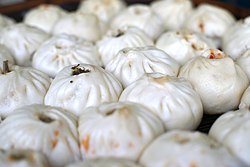
Back باوزي Arabic Паучи Bulgarian Bakpao BJN বাও Bengali/Bangla Baozi Catalan Baozi German Baozi Spanish Baozi Estonian Baozi Finnish Baozi French
This article needs additional citations for verification. (September 2014) |
 Meat-filled baozi for sale in a market | |
| Alternative names | Bao, humbow, pau, Pao-tsih |
|---|---|
| Type | Filled steamed bread |
| Place of origin | China |
| Region or state | Greater China, East Asia, Chinatown all over the world |
| Variations | Dabao, xiaobao |
| Baozi | |||||||||||||||||||||
|---|---|---|---|---|---|---|---|---|---|---|---|---|---|---|---|---|---|---|---|---|---|
"Baozi" in Chinese characters | |||||||||||||||||||||
| Chinese | 包子 | ||||||||||||||||||||
| |||||||||||||||||||||
| Alternative Chinese name | |||||||||||||||||||||
| Chinese | 包 | ||||||||||||||||||||
| |||||||||||||||||||||
Baozi (Chinese: ), or simply bao, is a type of yeast-leavened filled bun[1] in various Chinese cuisines. There are many variations in fillings (meat or vegetarian) and preparations, though the buns are most often steamed. They are a variation of mantou from Northern China.
Two types are found in most parts of China: Dàbāo (大包, "big bun"), measuring about ten centimetres (four inches) across, served individually, and usually purchased for take-away. The other type, Xiǎobāo (小包, "small bun"), measures approximately five centimetres (two inches) wide, and are most commonly eaten in restaurants, but may also be purchased for take-away. Each order consists of a steamer containing between three and ten pieces. A small ceramic dish for dipping the baozi is provided for vinegar or soy sauce, both of which are available in bottles at the table, along with various types of chili and garlic pastes, oils or infusions, fresh coriander and leeks, sesame oil, and other flavorings.
Baozi are popular throughout China and have made their way into the cuisines of many other countries through the Chinese diaspora.
- ^ Phillips, C. (2016). All Under Heaven: Recipes from the 35 Cuisines of China. Ten Speed Press. p. 405. ISBN 978-1-60774-982-0. Retrieved November 5, 2016.
© MMXXIII Rich X Search. We shall prevail. All rights reserved. Rich X Search